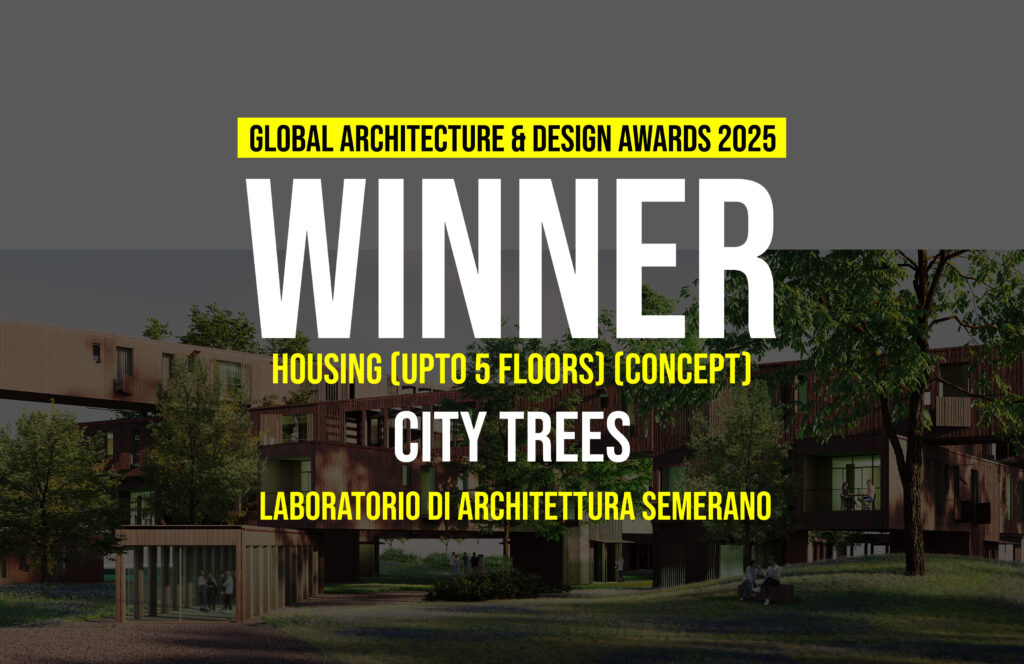City Trees is an innovative architectural project based on the industrial production of modular housing units made from wood and steel. These modules are designed to be easily combined into larger living spaces and arranged across four levels. The goal is to create a new form of urban living that is lightweight, flexible, expandable, and deeply integrated with nature.
Global Design & Architecture Design Awards 2025
First Award | Housing Upto 5 Floors (Concept)
Project Name: City Trees
Category: Housing Upto 5 Floors (Concept)
Studio Name: Laboratorio di Architettura Semerano
Design Team: Toti Semerano, Salvatore Musarò, Ludovica Fava, Stefano Sabato, Riccardo Catamo
Area: 40000 m2
Year: 2025
Location: San Biagio di Callalta, Treviso
Consultants:
Photography Credits:
Render Credits: Image courtesy of Laboratorio di Architettura Semerano
Other Credits:
The basic module measures 25 m² and can be aggregated into units of 50 or 75 m². These units can be configured in double, triple, or quadruple combinations. When assembled, the modules form beam-wall structures that are suspended in space, allowing the creation of complex and adaptable architectural forms. Some modules are intentionally left empty to become garden-terraces, forming “maxi-beams” that rise to various heights and intersect via staircases and elevated walkways. These connections link not only the living spaces but also underground parking and public services.
One of the defining features of City Trees is its strong connection to nature, both conceptually and physically. The system draws direct inspiration from the morphology of trees: trunks act as vertical load-bearing and distribution structures, while branches serve as the modular living units. This design results in an urban forest composed of “living” buildings made predominantly from wood, where greenery is not added decoratively, but integrated structurally and functionally.
Green spaces play a vital role in this system. Hanging gardens, terraces, and trees at various levels improve the microclimate, provide privacy, and ensure constant visual and physical contact with nature. The gaps between structures become urban forests and communal green areas that contribute to residents’ well-being and enhance environmental sustainability.
The ground floor of the complex houses public and neighborhood services such as daycare centers and coworking spaces, promoting community engagement. The upper floors are residential, but also accommodate shared spaces that encourage social interaction among inhabitants.
The design is highly modular, not only in the housing units but also in all architectural components. Windows, doors, balconies, beds, closets, and furnishings are all customizable and adaptable to different configurations. Technical systems are seamlessly integrated into the structure: plumbing is concealed under the floor within laminated beams, while electrical wiring runs in the suspended ceilings.
Energy sustainability is a key focus. Each 25 m² module is energy self-sufficient, equipped with rooftop photovoltaic panels that generate an average of 3.8 kW, meeting the energy needs of the inhabitants without external dependency.
The overall system offers high adaptability, allowing vertical and horizontal expansion to suit various urban contexts. Its use of eco-friendly materials and reduced ecological footprint aligns with principles of environmental responsibility. Moreover, the presence of shared social spaces supports inclusivity and community living.
In summary, City Trees represents a forward-thinking vision of urban housing that blurs the boundaries between built environment and nature. It proposes a new cityscape where architecture functions like a forest—alive, dynamic, and sustainable—meeting the needs of both individuals and communities while fostering harmony with the natural world.
